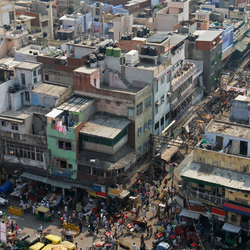In a city like Toronto, the water never stops running. There’s always pressure conveniently pushing clean water into our homes for on-demand consumption.
But that’s not how the whole world works.
More than a billion people get their daily water needs from water networks called Intermittent Water Supplies (IWS). That means, rather than constantly flowing like we are accustomed to here on campus, 21 percent of the world’s water pipes turn on and off every day.

In Delhi, India, the water utility typically supplies water to residents for two hours in the morning and one hour in the evening, forcing people to store all the water they’ll need to get through the day or night.
In other cities, the process is a little more chaotic. You might never know when the water is coming on until you hear the water rushing through the pipes—and that could be at 3:00 am while you’re fast asleep, or in the middle of the afternoon when everybody’s at work or school.
At University of Toronto, Prof. David Meyer’s research group works on building new models and tools to help improve the fairness and quality of the service provided in the cities using IWS.
“In most intermittent supplies, the pipes are unpressurized or even negatively pressurized for hours or sometimes days at a time, which means contaminants like rainwater or even sewage can sneak into the pipes and contaminate the drinking water.”
It’s not just a question about quality, but also a matter of how fairly the water quantity is divided (equality).
“If you live close to the reservoir, you might get more water than the person who lives at the top of hill, far away from the reservoir,” explains Meyer.
We’ve considered quality, quantity and equality—but what about equity? That’s the topic of Meyer’s latest research project.

“For five different cities in India, we’re looking at whether or not there’s a correlation between the type of water supply schedule (long, reliable, and/or convenient) you have and the degree of your social marginalization. The first step to improving equity is knowing there is a problem; we hope we’re wrong, but believe that the socially marginalized are more likely to have short, inconvenient water supply schedules.”
Meyer hopes his research will push city planners and local governments to invest more money in this essential infrastructure that often gets ignored because we can’t necessarily see it.
“As countries and economies grow, there’s more money for infrastructure and there’s more aspirations for high quality infrastructure. Many growing cities pay a lot of money to try and take their water pipe networks from ‘dysfunctional’ to ‘excellent’, and sometimes they succeed. But more often, aspirations of ‘excellent’ result in unrealistic projects that fail. I wish we could design projects that would make meaningful, incremental progress, but It’s hard to convince people to spend money knowing the end result will be less than ‘excellent’.”
Learn more about Prof. Meyer’s research on IWS
BACK TO WORLD WATER DAY STORIES
By David Goldberg